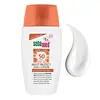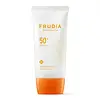What's inside
What's inside
 Key Ingredients
Key Ingredients

 Benefits
Benefits

 Concerns
Concerns

 Ingredients Side-by-side
Ingredients Side-by-side

Water
Skin ConditioningDibutyl Adipate
EmollientOctocrylene
UV AbsorberC12-15 Alkyl Benzoate
AntimicrobialGlycerin
HumectantButyl Methoxydibenzoylmethane
UV AbsorberTitanium Dioxide
Cosmetic ColorantVp/Eicosene Copolymer
Dimethicone
EmollientLauryl Glucoside
CleansingPanthenol
Skin ConditioningMicrocrystalline Cellulose
AbsorbentBis-Ethylhexyloxyphenol Methoxyphenyl Triazine
Skin ConditioningTocopheryl Acetate
AntioxidantPolyglyceryl-2 Dipolyhydroxystearate
Skin ConditioningPhenoxyethanol
PreservativeSodium Cetearyl Sulfate
CleansingBenzyl Alcohol
PerfumingDiethylhexyl Butamido Triazone
UV AbsorberCellulose Gum
Emulsion StabilisingSilica
AbrasiveParfum
MaskingSorbic Acid
PreservativeEthylhexylglycerin
Skin ConditioningDisodium EDTA
Xanthan Gum
EmulsifyingDehydroacetic Acid
PreservativeInulin
Skin ConditioningLecithin
EmollientWater, Dibutyl Adipate, Octocrylene, C12-15 Alkyl Benzoate, Glycerin, Butyl Methoxydibenzoylmethane, Titanium Dioxide, Vp/Eicosene Copolymer, Dimethicone, Lauryl Glucoside, Panthenol, Microcrystalline Cellulose, Bis-Ethylhexyloxyphenol Methoxyphenyl Triazine, Tocopheryl Acetate, Polyglyceryl-2 Dipolyhydroxystearate, Phenoxyethanol, Sodium Cetearyl Sulfate, Benzyl Alcohol, Diethylhexyl Butamido Triazone, Cellulose Gum, Silica, Parfum, Sorbic Acid, Ethylhexylglycerin, Disodium EDTA, Xanthan Gum, Dehydroacetic Acid, Inulin, Lecithin
Water
Skin ConditioningEthylhexyl Methoxycinnamate
UV AbsorberTitanium Dioxide
Cosmetic ColorantGlycerin
HumectantDipropylene Glycol
HumectantDibutyl Adipate
EmollientC12-15 Alkyl Benzoate
AntimicrobialDiethylamino Hydroxybenzoyl Hexyl Benzoate
UV FilterNiacinamide
SmoothingEthylhexyl Triazone
UV AbsorberGlyceryl Stearate
EmollientCetearyl Alcohol
EmollientCetyl Alcohol
EmollientPolysorbate 60
EmulsifyingDimethicone
EmollientPEG-100 Stearate
Aluminum Hydroxide
EmollientCetearyl Olivate
Glyceryl Caprylate
EmollientSorbitan Olivate
EmulsifyingPolyhydroxystearic Acid
EmulsifyingHydroxyethyl Acrylate/Sodium Acryloyldimethyl Taurate Copolymer
Emulsion StabilisingStearyl Alcohol
EmollientCetearyl Glucoside
EmulsifyingMethicone
EmollientTocopheryl Acetate
AntioxidantMyristyl Alcohol
EmollientAdenosine
Skin ConditioningLauryl Alcohol
EmollientSorbitan Isostearate
EmulsifyingPearl Powder
Citrus Unshiu Peel Extract
MaskingCoco-Caprylate/Caprate
EmollientButylene Glycol
HumectantGlucose
HumectantMacadamia Ternifolia Seed Oil
EmollientVitis Vinifera Seed Oil
EmollientPrunus Armeniaca Kernel Oil
MaskingPropylene Glycol
HumectantPEG-5 Rapeseed Sterol
CleansingCholesterol
EmollientBrassica Campestris Sterols
EmollientBiosaccharide Gum-4
Skin ConditioningMangifera Indica Fruit Extract
Skin ConditioningHydrogenated Lecithin
EmulsifyingGlutathione
Garcinia Mangostana Peel Extract
Skin ConditioningCeteth-5
EmulsifyingCeteth-3
EmulsifyingSolanum Lycopersicum Seed Oil
EmollientSodium Ascorbyl Phosphate
AntioxidantPunica Granatum Seed Oil
EmollientMangifera Indica Seed Oil
EmollientCitrus Paradisi Seed Oil
PerfumingCetyl Phosphate
EmulsifyingEthylhexylglycerin
Skin ConditioningMalpighia Emarginata Fruit Extract
Skin ConditioningTocopherol
AntioxidantPhenoxyethanol
Preservative1,2-Hexanediol
Skin ConditioningChlorphenesin
AntimicrobialDisodium EDTA
Parfum
MaskingCoumarin
PerfumingAlpha-Isomethyl Ionone
PerfumingCitronellol
PerfumingHydroxycitronellal
PerfumingWater, Ethylhexyl Methoxycinnamate, Titanium Dioxide, Glycerin, Dipropylene Glycol, Dibutyl Adipate, C12-15 Alkyl Benzoate, Diethylamino Hydroxybenzoyl Hexyl Benzoate, Niacinamide, Ethylhexyl Triazone, Glyceryl Stearate, Cetearyl Alcohol, Cetyl Alcohol, Polysorbate 60, Dimethicone, PEG-100 Stearate, Aluminum Hydroxide, Cetearyl Olivate, Glyceryl Caprylate, Sorbitan Olivate, Polyhydroxystearic Acid, Hydroxyethyl Acrylate/Sodium Acryloyldimethyl Taurate Copolymer, Stearyl Alcohol, Cetearyl Glucoside, Methicone, Tocopheryl Acetate, Myristyl Alcohol, Adenosine, Lauryl Alcohol, Sorbitan Isostearate, Pearl Powder, Citrus Unshiu Peel Extract, Coco-Caprylate/Caprate, Butylene Glycol, Glucose, Macadamia Ternifolia Seed Oil, Vitis Vinifera Seed Oil, Prunus Armeniaca Kernel Oil, Propylene Glycol, PEG-5 Rapeseed Sterol, Cholesterol, Brassica Campestris Sterols, Biosaccharide Gum-4, Mangifera Indica Fruit Extract, Hydrogenated Lecithin, Glutathione, Garcinia Mangostana Peel Extract, Ceteth-5, Ceteth-3, Solanum Lycopersicum Seed Oil, Sodium Ascorbyl Phosphate, Punica Granatum Seed Oil, Mangifera Indica Seed Oil, Citrus Paradisi Seed Oil, Cetyl Phosphate, Ethylhexylglycerin, Malpighia Emarginata Fruit Extract, Tocopherol, Phenoxyethanol, 1,2-Hexanediol, Chlorphenesin, Disodium EDTA, Parfum, Coumarin, Alpha-Isomethyl Ionone, Citronellol, Hydroxycitronellal
 Reviews
Reviews

Ingredients Explained
These ingredients are found in both products.
Ingredients higher up in an ingredient list are typically present in a larger amount.
C12-15 Alkyl Benzoate is made up of Benzoic Acid and long chain alcohols. It has a low molecular weight.
C12-15 Alkyl Benzoate is an emollient and texture enhancer. Due to its solubility, it is often used in sunscreens to help evenly distribute active ingredients.
As an emollient, C12-15 Alkyl Benzoate helps soften and hydrate your skin. Emollients create a film on your skin that traps moisture within.
This ingredient has been reported to cause eye irritation.
Learn more about C12-15 Alkyl BenzoateDibutyl Adipate is an emollient and solvent. It is created from butyl alcohol and adipic acid.
As a solvent, Dibutyl Adipate helps mix and disperse ingredients evenly.
Dibutyl Adipate is soluble in water and organic solvents. It does not absorb UV rays.
Learn more about Dibutyl AdipateDimethicone is a type of synthetic silicone created from natural materials such as quartz.
What it does:
Dimethicone comes in different viscosities:
Depending on the viscosity, dimethicone has different properties.
Ingredients lists don't always show which type is used, so we recommend reaching out to the brand if you have questions about the viscosity.
This ingredient is unlikely to cause irritation because it does not get absorbed into skin. However, people with silicone allergies should be careful about using this ingredient.
Note: Dimethicone may contribute to pilling. This is because it is not oil or water soluble, so pilling may occur when layered with products. When mixed with heavy oils in a formula, the outcome is also quite greasy.
Learn more about DimethiconeDisodium EDTA plays a role in making products more stable by aiding other preservatives.
It is a chelating agent, meaning it neutralizes metal ions that may be found in a product.
Disodium EDTA is a salt of edetic acid and is found to be safe in cosmetic ingredients.
Learn more about Disodium EDTAEthylhexylglycerin (we can't pronounce this either) is commonly used as a preservative and skin softener. It is derived from glyceryl.
You might see Ethylhexylglycerin often paired with other preservatives such as phenoxyethanol. Ethylhexylglycerin has been found to increase the effectiveness of these other preservatives.
Glycerin is already naturally found in your skin. It helps moisturize and protect your skin.
A study from 2016 found glycerin to be more effective as a humectant than AHAs and hyaluronic acid.
As a humectant, it helps the skin stay hydrated by pulling moisture to your skin. The low molecular weight of glycerin allows it to pull moisture into the deeper layers of your skin.
Hydrated skin improves your skin barrier; Your skin barrier helps protect against irritants and bacteria.
Glycerin has also been found to have antimicrobial and antiviral properties. Due to these properties, glycerin is often used in wound and burn treatments.
In cosmetics, glycerin is usually derived from plants such as soybean or palm. However, it can also be sourced from animals, such as tallow or animal fat.
This ingredient is organic, colorless, odorless, and non-toxic.
Glycerin is the name for this ingredient in American English. British English uses Glycerol/Glycerine.
Learn more about GlycerinParfum is a catch-all term for an ingredient or more that is used to give a scent to products.
Also called "fragrance", this ingredient can be a blend of hundreds of chemicals or plant oils. This means every product with "fragrance" or "parfum" in the ingredients list is a different mixture.
For instance, Habanolide is a proprietary trade name for a specific aroma chemical. When used as a fragrance ingredient in cosmetics, most aroma chemicals fall under the broad labeling category of “FRAGRANCE” or “PARFUM” according to EU and US regulations.
The term 'parfum' or 'fragrance' is not regulated in many countries. In many cases, it is up to the brand to define this term.
For instance, many brands choose to label themselves as "fragrance-free" because they are not using synthetic fragrances. However, their products may still contain ingredients such as essential oils that are considered a fragrance by INCI standards.
One example is Calendula flower extract. Calendula is an essential oil that still imparts a scent or 'fragrance'.
Depending on the blend, the ingredients in the mixture can cause allergies and sensitivities on the skin. Some ingredients that are known EU allergens include linalool and citronellol.
Parfum can also be used to mask or cover an unpleasant scent.
The bottom line is: not all fragrances/parfum/ingredients are created equally. If you are worried about fragrances, we recommend taking a closer look at an ingredient. And of course, we always recommend speaking with a professional.
Learn more about ParfumPhenoxyethanol is a preservative that has germicide, antimicrobial, and aromatic properties. Studies show that phenoxyethanol can prevent microbial growth. By itself, it has a scent that is similar to that of a rose.
It's often used in formulations along with Caprylyl Glycol to preserve the shelf life of products.
Titanium dioxide is a mineral UV filter widely used in sunscreens and cosmetics.
It is one of only two UV filters officially classified as “mineral” by regulatory agencies, the other being zinc oxide.
Titanium dioxide provides broad-spectrum protection mostly in the UVB and UVAII range, with some protection in the UVAI range.
While its UVA protection isn’t as strong as zinc oxide’s, the difference is minor.
A common myth is that mineral UV filters reflect UV light. However, modern research shows titanium dioxide absorbs UV radiation like chemical filters (~95% absorption & 5% reflection).
Thanks to its non-irritating nature, titanium dioxide is suitable for sensitive, acne-prone, or redness-prone skin. It is unlikely to cause "eye sting" like other sunscreen ingredients.
A major drawback of this ingredient is its white cast and thick texture. This is why mineral sunscreens often leave a white cast and are less cosmetically elegant than chemical/hybrid sunscreens.
To improve white cast and spreadability, micronized or nano-sized titanium dioxide is often used.
There are ongoing concerns surrounding nano-titanium oxide's impact on marine ecosystems.
There is no conclusive evidence that any form of titanium oxide (or any other sunscreen ingredients) will cause harm to marine ecosystems or coral reefs. The science is still developing but many consumers are keeping a close eye on this issue.
Please note, many destinations have reef-safety sunscreen rules. For instance, the U.S. Virgin Islands advises all visitors to use non-nano mineral sunscreens.
Nano mineral sunscreens once raised safety concerns about absorption into skin.
Extensive research has shown that they do not penetrate healthy or damaged skin; they remain safely on the surface and the top layer of dead skin (stratum corneum).
You'll likely find titanium dioxide bundled with alumina, silica, or dimethicone. These ingredients help make titanium dioxide highly photostable; this prevents it from interacting with other formula components under UV light.
Learn more about Titanium DioxideTocopheryl Acetate is AKA Vitamin E. It is an antioxidant and protects your skin from free radicals. Free radicals damage the skin by breaking down collagen.
One study found using Tocopheryl Acetate with Vitamin C decreased the number of sunburned cells.
Tocopheryl Acetate is commonly found in both skincare and dietary supplements.
Learn more about Tocopheryl AcetateWater. It's the most common cosmetic ingredient of all. You'll usually see it at the top of ingredient lists, meaning that it makes up the largest part of the product.
So why is it so popular? Water most often acts as a solvent - this means that it helps dissolve other ingredients into the formulation.
You'll also recognize water as that liquid we all need to stay alive. If you see this, drink a glass of water. Stay hydrated!
Learn more about Water